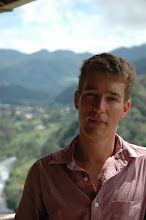Reflections on Turkmenistan
I'm staying in Uzbekistan at a place called Khiva which is a perfectly preserved mud coloured old city with exquisite blue tiled decoration everywhere you look. It looks like the film set for an Indiana Jones movie. Khiva has a pretty goulish history too. When under the control of the Khivan Khans and during the period of The Great Game in Central Asia, it was a place you were unlikely to get out of alive should you have been mad enough to try to visit it in the first place. Our guide lovingly described the favourite forms of execution as being public impalement on a spike, being thrown off the top of a minaret, and, this one exclusivly for women, being tied up in a sack with wild cats. Fortunately times changed after the Russians took control and these days Khiva is a much more welcoming place, though a little devoid of life in its ancient heart as the local authorities appear to have moved the majority of the inhabitants out of the centre as part of the restoration programme. Khiva has more of a touristy feel (though still pretty light touch) than anywhere we've been since Turkey, but there are no tourists to be seen. I'm unclear whether this is due to seasonal factors (it's about 45 C here at the moment) or whether tourists are staying away from the country presently.
Another bewilderingly empty city at its centre is Ashgabad in Turkmenistan, which I neglected to describe in my last post. Turkmenistan has been described as the North Korea of Central Asia and we had to be careful what we wrote and said when in the country as communications are monitored and the bugging of buildings is reputedly widespread. Turkmenistan is run by an eccentric President known universally by his self-appointed title of Turkmenbashi (Great Leader of Turkmen). He is particularly enamoured of putting giant busts and medallian portraits of himself just about everywhere they can conceivably go in the country, along with statutes of his personally penned history and culture of the Turkmen people called the 'Rukhama', which is apparantly set text reading in every school. However the real focus of his endeavours is Ashgabad which has been extensively rebuilt over the past dozen years with a whole load of utterly bonkers buildings and public monuments, many of them water guzzling fountains in a land that is three-quarters desert. The centrepiece is the monstrous Arch of Neutrality which looks like a giant 50 m high ray gun with a golden statute of the President on top which revolves through the course of the day so as always to face the sun. When I visited the Arch the golden leader was gazing in the direction of the rather Orwellian named Ministry of Fairness building.
Yet, if the architecture in Ashgabad is an overblown crime against asthetics, it can't be denied that it's also a fascinating sight to see. The Turkmen people are also the loveliest and friendliest we've met along the way and surprisingly at ease with Western tourists given how few people actually visit the country. We really got to see them close up at the famous Sunday market outside of the city where among other things I bought a traditional Turkman hat that looks like a giant 1970s black afro haircut and is made from sheep wool.
Leaving Turmenistan required a two day drive across the Karakam Desert, our first desert of the trip and a pretty bleak place it was too. All insect life seemed miraculously to treble in size which was a bit daunting at night.
Still enjoying the food on this trip though there has been a noticeable shift towards lamb kebabs in the Central Asian section - they're everywere. I did have the opportunity to have an 'Under Fur Salad' when in Baku but decided to save that for another visit. The 'Bolted Fish' was delicious however.


0 Comments:
Post a Comment
Subscribe to Post Comments [Atom]
<< Home